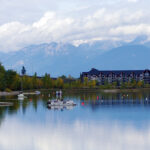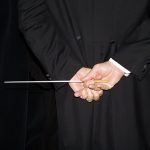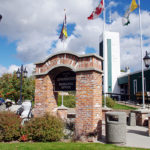Home »
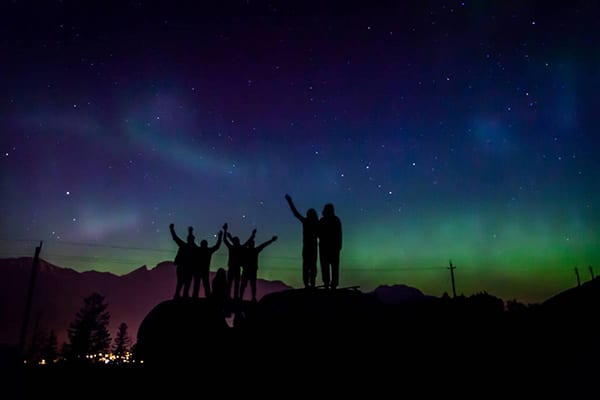
Leonid meteor shower peaks this weekend
By Rick Nowell
The Leonid meteor shower is this weekend.
Leonids: This shower occurs between Nov. 6 and Nov. 30, peaking on Saturday, Nov. 17 at 4 p.m. (23 hr UT). These meteors have fairly fast speeds of 71 km/s at rates of 15 meteors/hr, with fast green trails. They radiate out from the constellation Leo on the eastern horizon. This is ice debris from comet Tempel-Tuttle. There are a variety of sizes, from dust, ice grains to pea-sized ice-pellets. The pea-sized pellets create bright fireballs with glowing streaks behind them that take a few seconds to fade away. These meteors never hit the ground; the biggest may get down only to 75km high.
Next month are the excellent Geminids: they occur between Dec. 4 and Dec. 17, peaking on Friday, Dec 14 at 5:30 a.m. (12:30 UT). They have medium speeds of 35km/s and much higher rates of 120 meteors/hr (or one every 30 seconds).
The Geminids are the finest and most reliable of the major showers, with lots of bright, medium 35 km/s meteors, whose peak lasts for a day. These are debris from an asteroid (3200 Phaethon) so they are rock based, not ice based. Due to the metals and minerals in the rocks, they can be various bright colours, but due to their slower speeds, they don’t leave glowing streaks behind them.
Colours in meteor tails
Some fireballs can be a bluish-green, others white/yellow and red. Green can be caused by copper or magnesium metal burning. Other colours like yellow can be iron burning (like steel wool), orange can be sodium burning and red can be silicates.
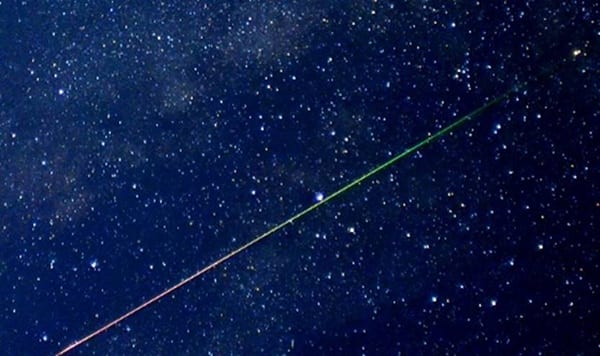
Ionization trails: the word meteoros is Greek for “high in the air.” And they are high up at 70 to 120 km altitude where the air is thin. The fast meteor will heat the air into a glowing plasma, ionizing the nitrogen and oxygen gases in the atmosphere. At higher collision energies oxygen will glow green. Nitrogen glows blue at medium energies and red at low collision energies. Thus fast meteor showers with more energy would produce more blues and greens, slow meteors showers with lower energy, more reds. In fact, some meteors start off blue, and fade to red as they slow down. Sometimes the ionization trail glow persists for a few seconds before fading out. The Leonid Meteor shower often has green meteors.
Sporatic meteors: there doesn’t have to be a meteor shower occurring, since on any average night you may see ten bright fireballs from random sources.
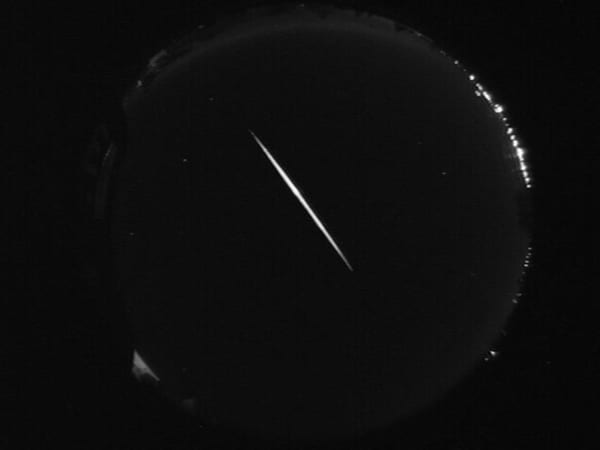
NORTHERN LIGHT Photos of Sunday, Nov. 5
Note a fuzzy band across the northern horizon in the meteor fisheye lens picture above. The Northern Lights peaked Sunday night at 10:25 p.m. according to our meteor cam: according to NOAA it was a Kp=6 mild geomagnetic G2 storm*. Any Kp* of five or above can be seen from Cranbrook. They happen about once a month with a couple of strong flares one each year. They generally occur between 11 p.m. and 3 a.m. along the Northern horizon.
When to look? You can get a three-day “space weather” forecast from the NOAA.
*NOAA uses magnetic field measurements to estimate geomagnetic storm intensities, and assigns a Kp number of 1 to 9: “Storms also result in intense currents in the magnetosphere, changes in the radiation belts, and changes in the ionosphere, including heating the ionosphere and upper atmosphere region called the thermosphere. In space, a ring of westward current around Earth produces magnetic disturbances on the ground. A measure of this current, the disturbance storm time (Dst) index, has been used historically to characterize the size of a geomagnetic storm. In addition, there are currents produced in the magnetosphere that follow the magnetic field, called field-aligned currents, and these connect to intense currents in the auroral ionosphere. These auroral currents, called the auroral electrojets, also produce large magnetic disturbances. Together, all of these currents, and the magnetic deviations they produce on the ground, are used to generate a planetary geomagnetic disturbance index called Kp. This index is the basis for one of the three NOAA Space Weather Scales, the Geomagnetic Storm, or G-Scale, that is used to describe space weather that can disrupt systems on Earth.” Source: NOAA website.
On NOAAs G-SCALE: G1 is a MINOR storm (Kp=5), G2 MODERATE (Kp=6: gray aurora seen in Cranbrook), G3 STRONG (Kp=7:strong enough for colours to be seen in Cranbrook, and the aurora can be seen as far south as Vancouver), G4 SEVERE (Kp=8:aurora seen as far South as California) and G5 EXTREME (Kp=9: power outages, aurora seen in Florida).
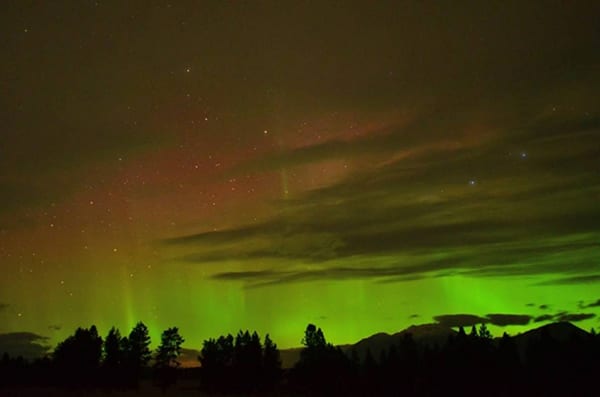
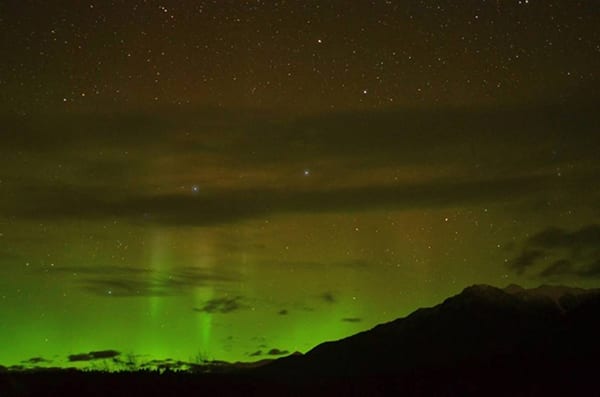
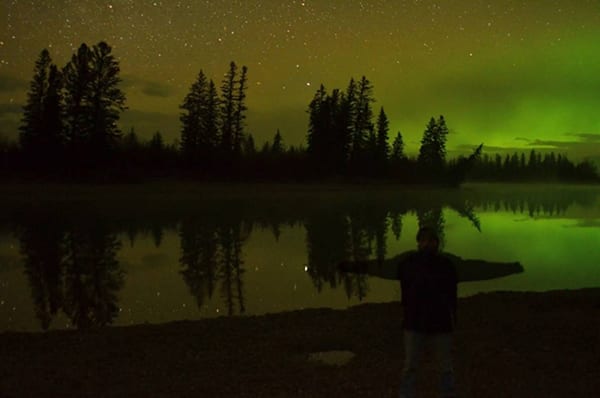
What makes the Aurora Borealis colours?
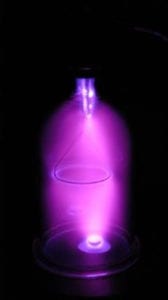 The green glow comes from electrons and protons from the sun spiralling down the Earth’s north magnetic pole towards Hudson’s Bay, hitting oxygen molecules 100 km up in the edge of the atmosphere. The red glow occurs with oxygen too, but even higher up, at 200 km. The blues are produced by ionized nitrogen molecules between 100 and 200 km. And crimsons from neutral nitrogen below 100km.
The green glow comes from electrons and protons from the sun spiralling down the Earth’s north magnetic pole towards Hudson’s Bay, hitting oxygen molecules 100 km up in the edge of the atmosphere. The red glow occurs with oxygen too, but even higher up, at 200 km. The blues are produced by ionized nitrogen molecules between 100 and 200 km. And crimsons from neutral nitrogen below 100km.
At low pressures, the air molecules are spaced wide enough apart to glow at these energies, but you won’t see the glow lower than ~80km where air molecules are packed too close together.
We can make an Aurora glow in our COTR Physics lab too. Here we use a glass bell jar, and pump the air out with a vacuum pump to 1/100 of an atmosphere in pressure to approximate the high altitude. Instead of the solar wind, we put 5,000 volts across it until the air conducts electrons as electrical current and it glows. The electrodes get hot so we can’t run it too long. The glowing gas inside is ordinary air, with 78% nitrogen and 21% oxygen.
Lead image: 8 This is the Aurora seen from Fernie on May 7, 2016. It was a powerful solar flare; you can see blues and crimsons as well. The photo faces north from Fernie, with Cassiopeia just above the heads of the couple on the right. Photo sent by Sasha Prystae of Kimberley.
– Rick Nowell is the Astronomy Lab Tech at College of the Rockies


